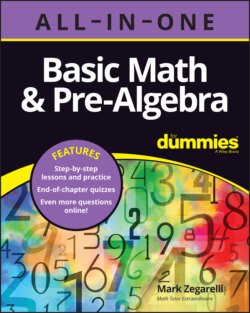Читать книгу Basic Math & Pre-Algebra All-in-One For Dummies (+ Chapter Quizzes Online) - Mark Zegarelli - Страница 68
Getting with the In-Group: Parentheses and the Associative Property
ОглавлениеParentheses allow you to group operations together, telling you to do any operations inside a set of parentheses before you do operations outside of it. Parentheses can make a big difference in the result you get when solving a problem, especially in a problem with mixed operations. In two important cases, however, moving parentheses doesn’t change the answer to a problem:
The associative property of addition says that when every operation is addition, you can group numbers however you like and choose which pair of numbers to add first; you can move parentheses without changing the answer.
The associative property of multiplication says you can choose which pair of numbers to multiply first, so when every operation is multiplication, you can move parentheses without changing the answer.
In contrast, subtraction and division are non-associative operations. This means that grouping them in different ways changes the result.
Don’t confuse the commutative property with the associative property. The commutative property tells you that it’s okay to switch two numbers that you’re adding or multiplying. The associative property tells you that it’s okay to regroup three (or more) numbers using parentheses.
Taken together, the associative property and the commutative property (which I discuss in the preceding section) allow you to completely rearrange all the numbers in any problem that’s either all addition or all multiplication.
Q. What’s What’s
A. 5 and 19. To calculate , first do the operation inside the parentheses — that is, :
Now finish the problem by dividing
To solve , first do the operation inside the parentheses — that is, :
Finish up by subtracting . Notice that the placement of the parentheses changes the answer.
Q. Solve .
A. 12 and 12. To solve , first do the operation inside the parentheses — that is, :
Finish up by adding .
To solve , first do the operation inside the parentheses — that is, :
Finish up by adding . Notice that the only difference between the two problems is the placement of the parentheses, but because both operations are addition, moving the parentheses doesn’t change the answer.
Q. Solve
A. 24 and 24. To solve first do the operation inside the parentheses — that is,
Finish by multiplying
To solve first do the operation inside the parentheses — that is,
Finish by multiplying . No matter how you group the multiplication, the answer is the same.
Q. Solve
A. 410. The last two numbers are small, so place parentheses around these numbers:
First, do the multiplication inside the parentheses:
Now you can easily multiply
5 Find the value of
6 Find the value of
7 Solve the following two problems:
(a)
(b)
Do the parentheses make a difference in the answers?
8 Solve the following two problems:
(a)
(b)
Do the parentheses make a difference in the answers?
9 Solve the following two problems:
(a)
(b)
Do the parentheses make a difference in the answers?
10 Find the value of . (Hint: Use the associative property for multiplication to make the problem easier.)
